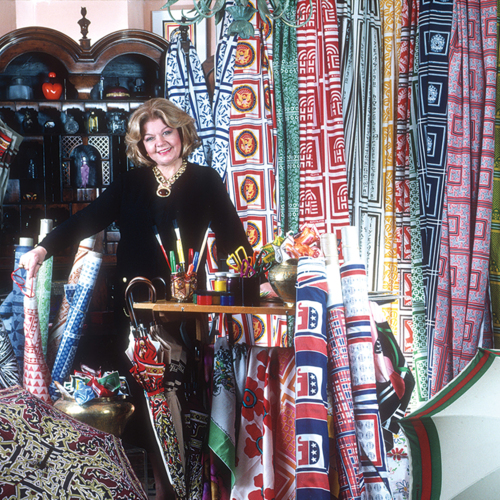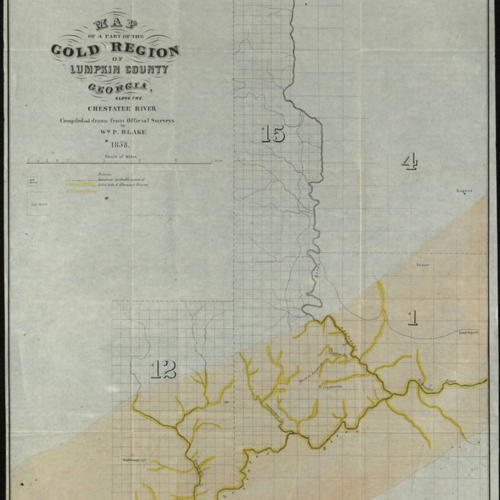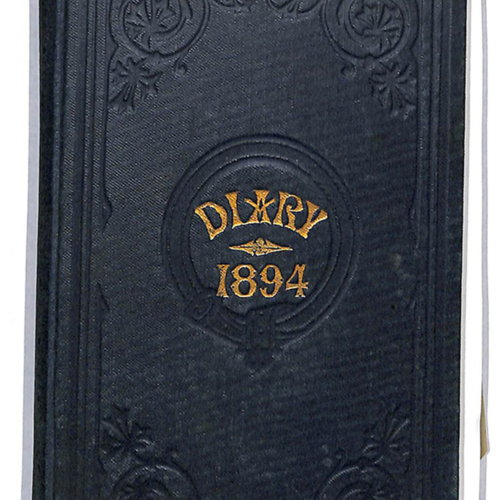Browse Exhibits (19 total)
Frankie Welch’s Americana: Fashion, Scarves, and Politics

Frankie Welch (1924-2021) was an American designer and entrepreneur best known for producing thousands of custom scarves. Born in Rome, Georgia, she spent most of her career in Alexandria, Virginia, where she established a dress shop—Frankie Welch of Virginia—that was open from 1963 to 1990. She introduced her first scarf design, the Cherokee Alphabet, in 1967, quickly followed by her Discover America scarf for the White House and prominent political designs for the 1968 presidential election. From the early 1970s through the mid-1980s she primarily designed scarves based on an eight-by-eight-inch module, inspired by architect Frank Lloyd Wright. Her later scarves, which she designed until the late 1990s, were generally large format silk squares.
Frequently described as “Americana,” Welch’s designs provide a remarkable chronicle of American life, especially as she and her peers experienced it. The scarves document the causes they supported, the places they banked, where they studied and worked, the politicians they admired, and the businesses they owned. Her scarves constitute a unique body of work in the history of American fashion, standing apart from exclusively design- or art-based scarves because of Welch’s embrace of their commercial and documentary possibilities.
This exhibit presents an overview of her career and highlights her many connections to presidential politics, Georgia, and the University of Georgia. It was made possible with support from the Lucy Hargrett Draper Center and Archives for the Study of the Rights of Women in History and Law.
Gold-digging in Georgia: America’s First Gold Rush

California’s romanticized gold rush days obscure a longer history of American gold mining, one with deep roots in the southern Appalachian Mountains. A history of north Georgia from the late 1820s until the Civil War is a story of America’s first major gold rush, a southern one that preceded the California frenzy. This antebellum Appalachian gold rush served as one of the many southern paths to industrialism; what began as a small extractive industry quickly reached an industrial scale. It was a crucial developmental period in Appalachian industrial history and that of the nation’s mineral economy.
Georgia gold fever, while profitable, was also destructive as it remade local economies, societies, and environments. In pursuit of wealth, miners ripped apart stream beds and hillsides, cut down forests, and erected miles of wooden flumes and towns of wooden shacks. Public and private mints sprang up to transform precious metal into currency and, with the help of the state and federal governments, speculators obsessed with the prospect of riches drove the Cherokee from Georgia.
Acknowledgements
This exhibit is based on the article “From Georgia to California and Back: The Rise, Fall, and Rebirth of Southern Gold Mining” by Dr. Drew Swanson, published in the Georgia Historical Quarterly, courtesy of the Georgia Historical Society. The Hargrett Library is thankful to Dr. Swanson for allowing the use of his research to guide the development of the exhibition and its content.
This exhibit was made possible by the generous support of John F. McMullan, the James W. Woodruff, Sr. Center for the Natural History of Georgia, and the Stephen E. Draper Center and Archives for the Study of Water Law and Policy.
Private! Keep out! Diaries of Girlhood

Diary keeping is a part of many childhoods. Girls, in particular, have been socialized to engage in this pastime, and have done so for centuries. In the early colonies, when young boys began working outside, girls were encouraged to focus on the household and domestic sphere. In addition to traditional household chores of cooking and cleaning, their expected tasks included writing letters and diaries, and keeping family genealogical records. These early diaries were mostly simple accounts of their daily lives, as girls were discouraged from reflecting on their experiences or dreaming of adventures in their writing.
It was not acceptable for girls to publicly express their ideas, intimate thoughts, or feelings either, so diaries eventually morphed into private spaces where girls began to explore their sense of self. It was in their diaries that they could express themselves more freely without fear of the social consequences of not complying with the limiting gendered expectations of the time. Girls have also turned to diaries during times of chaos and war, or during severe illness. In these unthinkable circumstances, diaries again serve as a refuge for young girls to voice fears and anxieties, and to process grief.
Diaries of Girlhood focuses on these intriguing snapshots from childhood. Curated by intern Terri Hatfield, the exhibit uses diaries from the collection of the Hargrett Rare Book and Manuscript Library to introduce visitors to Clara Barrow, Rita Scherman, and Dorothy du Rant, to name a few. It explores their joys, anxieties, and frustrations, their pastimes, their families, and communities.
The Office of Senator Richard B. Russell, Jr.
Supported by Charles and Ann Campbell, this space provides a representation of the United States Senator’s Washington office that includes much of his original furniture, photographs, books, and memorabilia. The space conveys both a personal sense of the man who served Georgia for thirty-eight years as well as a clear sense of the wide ranging activities, concerns, and responsibilities of a busy congressional office.
You can see images of Russell with constituents, colleagues, and family members, as well as plaques noting his various accomplishments. The bookcases are topped with model airplanes, many of which the Senator received while serving as Chair of the Senate Armed Services Committee. Many of the items on his desk provide a glimpse into his personal life and hobbies – a framed photograph of his father, Judge Richard B. Russell, Sr., an autographed baseball, and a small transistor radio (disguised as a telephone!) for listening to baseball games.
One thing that is missing from this office: clutter! In his real Senate Office, the large table in the center of the room would have been covered in books and papers, used in researching and writing legislation and keeping up with all the comings and goings on of the U.S. Senate. You can see the clutter captured in the photographs displayed on the center table.
Building Georgia Music Collections

With the Georgia Music Hall of Fame Collection as its cornerstone, the University of Georgia Special Collections Libraries embark on a new mission to build the largest archive of artifacts, instruments, textiles, photographs, recordings and ephemera documenting the state of Georgia's rich musical history. This site offers a look at our growing music archive across the Special Collections Libraries.
To see items from the collections on display consider a visit to the UGA Special Collections Building, or to see The Georgia Music Collections at the Akins Ford Arena.
Check out a list of current displays here:
https://digilab.libs.uga.edu/scl/exhibits/show/georgia-music-on-display
Help Build the Archives
- Donate your items that document music history in Georgia
(ex. concert posters, t-shirts, photographs)
- Suggest interviewees for music oral history projects
- Connect us to musicians, performers, or other industry
insiders that could contribute items to the collection
Click here to support The Georgia Music Collections with a gift!
Connect with Us!
Ryan Lewis
Georgia Music Curator
706-542-0625
ryanlewis@uga.edu
Georgia Music History Now On Display
With the Georgia Music Hall of Fame Collection as its cornerstone, the University of Georgia Special Collections Libraries have embarked on a new mission to build the largest archive of artifacts, instruments, textiles, photographs, recordings and ephemera documenting the state of Georgia's rich musical history. This site offers a look at items from our growing music archive currently on display at the UGA Special Collections Building, at the Akins Ford Arena in downtown Athens, as well as past installations.
Modular Clothing by Paloma St. James

Paloma St. James is a fashion line based in Atlanta, Georgia that is changing the way fashion works, proving the industry can be innovative and sustainable through modular clothing.
We invite you to explore and interact with the clothing displayed in this room. Swap a collar, change a sleeve, layer an overlay and see how a singlie piece transforms. Use the videos and tutorials on this screen as aids as you play with the clothing inside this space.
Show us what the future of fashion could look like! Once you have created your favorite look, snap a picture and post to IG #modularfashion @hargrettlibrary
